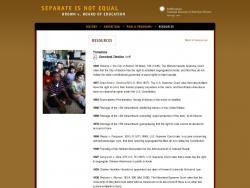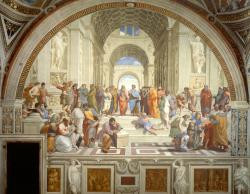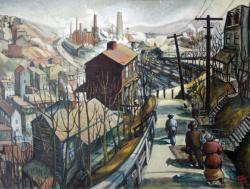Kate Harris
Social Studies teacher
Pittsburgh CAPA
Middle School (13 to 15 years old), High School (16 to 18 years old)
Teacher/Educator
Language Arts And English, Civics, Literature, Cultures, Economics, Social Studies, Geography, Writing, US History, Arts, Other
I'm a history-lover, art fan, and bookworm. I taught high school history (U.S. History and World Religions) for ten years in North Carolina, teach currently in Pittsburgh, PA, and am working to help teachers make the most of this new resource!
Kate Harris's collections
Dulce et Decorum Est--Poetry from World War I
<p>Why are artists' representations of war important? This student activity uses a poem by Wilfred Owen, "Dulce et Decorum Est," and several images to encourage reflection on soldiers' experiences and views of war. Students will explore the descriptive language and artistic choices made to determine what emotions are evoked by the art and what attitudes towards war are represented. Finally, students will be asked to consider and write about their own beliefs regarding war.</p>
 Kate Harris
Kate Harris
9
Frederick Douglass and "What to the Slave Is the Fourth of July?"
<p>In this collection, students will review the life of Frederick Douglass and learn about one of his most famous speeches, "The Meaning of Fourth of July for the Negro" (it is also commonly referred to as "What to the Slave is the Fourth of July). They will explore the strategies he uses to persuade and compare staged readings of the speech. Next, they will consider the central question posed by Douglass--how does the history of racial injustice in the United States affect our understanding of national symbols and what they mean? In addition, how do the diverse opinions of the many citizens of the United States present both challenges and opportunities for our nation? </p><p>Teachers may draw relevant connections to today and recent protests during the national anthem by professional, collegiate, and high school sports teams. </p>
 Kate Harris
Kate Harris
13
Communes, Counterculture, and the Back to the Land Movement
<p>This collection includes a variety of photographs taken by Lisa Law. Students will examine the photographs and a few artifacts and try to draw conclusions about the ways in which the commune or back-to-the-land movement challenged the norms of traditional United States society in the 1960s and 1970s. A link to an exhibit website is include and allows students to check their assumptions, and students are asked to compare elements of the counterculture with that of mainstream 1960s and 1970s culture. </p><p>Tags: counterculture, commune, hippie, granola, back to nature, communal living, co-op, cooperative, sixties, seventies, Woodstock, change over time, compare, ashram, silent majority</p>
 Kate Harris
Kate Harris
10
Visions of the Future
This student activity includes a range of visions of the future, to serve as inspiration and present a challenge for students: what do you want your city to be like in the future?
Students will watch a video where students complete a similar project, and then view a variety of artifacts presenting different views of the future, with questions for analysis. Finally, students will be tasked with developing their own vision for their city or town in the future.
 Kate Harris
Kate Harris
15
The End of World War I
This collection asks users to consider how unresolved issues from WWI may have led to the outbreak of war again in the 1930s. Included is a letter from a soldier on the end of the war, a summary of the Treaty of Versailles, a painting and a political cartoon.
The collection asks students to evaluate the predictions about future wars made by the letter's author and then to evaluate how and why the Treaty of Versailles may have failed.
Tags: World War I, Treaty of Versailles, League of Nations, armistice, interwar, World War I, Hitler
 Kate Harris
Kate Harris
5
Political Campaigns
How have political campaign strategies evolved over time? Use this collection of a variety of resources (artifact, poster, photograph, news article, video, and painting) to find an answer to the question. As you review the collection, take notes on the variety of issues, audiences, and tactics you see represented.
Tags: politics, campaign, election, vote, ballot box, Kennedy, Nixon, 1960, Obama, 2008, 1956, Eisenhower, Ike, Nixon, Harding, Republican, Democrat, suffrage, Lincoln, 1860
 Kate Harris
Kate Harris
6
Samurai Armor
This collection invites students to consider samurai armor as both functional and expressive objects. The collection includes two informative videos, several examples of samurai armor, photographs, and quiz questions. It finishes with an optional extension activity to make and decorate an origami samurai helmet. This collection can be used independently by students.
Guiding questions to consider are:
1) Why does the material, design, and purpose of an item of clothing matter?
2) How did samurai use their armor to affirm their social status?
3) How did samurai armor evolve over time and reflect changes in Japanese culture?
 Kate Harris
Kate Harris
19
Women in World War II
This collection teaches students about the changing role of women during World War II: their role in the workplace, increasing presence in the military, and participation in voluntary organizations that supported the war. Students should think about how these activities reinforced traditional notions of gender divisions while they also allowed women to experience new activities.
 Kate Harris
Kate Harris
23
The Military Draft
<p>This collection can be used for a teaching activity on the military draft in the United States and how it has changed over time from the Civil War to the Vietnam War. Students will consider attitudes towards the draft, its effects, and means of avoiding the draft in different eras. What trends or patterns emerge? What changes? Why is the draft no longer in use?</p><p>Tags: conscription, draft, selective service, Civil War, World War I, World War II, WWI, WWII, WW2, Vietnam War, change over time, continuity and change, exemption</p>
 Kate Harris
Kate Harris
23
Pittsburgh Landscape
<p>This collection was prepared for a workshop with Pittsburgh Public School teachers about integrating the visual arts with Social Studies curriculum. It models how to use the claim-support-question visible thinking strategy as well as the use of historic lenses that suggest different questions to ask about a work of art.</p><p><br /><br /></p><p>The content focus of this collection is Pittsburgh during the Great Depression. </p><p><br /><br /></p><p>Tags: Pittsburgh, Great Depression, 1930s, New Deal, steel mills, workers, economy</p>
 Kate Harris
Kate Harris
9
Alexander Gardner's Photographic Sketchbook of the War
<p>This is a collection of photographic plates from Alexander Gardner's Civil War Sketchbook that can be used for teaching about the Civil War in a number of ways. Students can explore the collection and look for images that help them learn about one of the following themes:</p><p>1) Technology</p><p>2) Military Strategy</p><p>3) Life in Military Camps</p><p>4) Death and Destruction</p><p>5) Photography as Art and Communication</p><p>The plates are in order as they appeared in the book, although some have not been included in order to limit the size of the collection. Note that some of the images have additional information linking to external websites with lesson ideas or simply more background on the particular photograph. In addition, be aware that each plate has two images, the first showing the photograph and the second showing Gardner's caption. The three final photos are not from the sketchbook, but show some of Gardner's more famous images and reveal more about the man himself.</p><p>WARNING: Some of the images in this collection include pictures of the dead on the battlefield, which some viewers may find disturbing. Please carefully consider whether use of this collection is appropriate for your specific audience.</p>
 Kate Harris
Kate Harris
40
Portraits of James Baldwin
<p>This student activity begins with an analysis of two portraits of James Baldwin by different artists. Then, students are asked to create their own portrait of Baldwin by remixing source material from this collection. Student portraits should answer the following questions:</p><p>1. How do you think James Baldwin should be remembered?</p><p>2. What are Baldwin's contributions to American life and culture?</p><p>Students may need to do additional research on Baldwin and his life in order to complete this assessment. This is an opportunity for students to learn about and explore the life of a revolutionary writer who presents a unique view of the civil rights movement and status of African-Americans in the United States.</p>
 Kate Harris
Kate Harris
25










